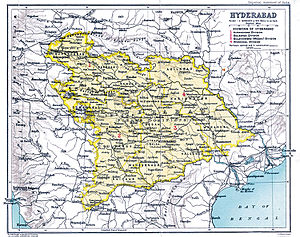Hyderabad State: Difference between revisions
→After the British Raj (1947-48): brevity |
|||
| Line 78: | Line 78: | ||
* Zubrzycki, John. (2006) ''The Last Nizam: An Indian Prince in the Australian Outback''. Pan Macmillan, Australia. ISBN 978-0-3304-2321-2. |
* Zubrzycki, John. (2006) ''The Last Nizam: An Indian Prince in the Australian Outback''. Pan Macmillan, Australia. ISBN 978-0-3304-2321-2. |
||
(1911) |
(1911) |
||
1 |
|||
==External links== |
==External links== |
||
Revision as of 19:13, 17 May 2009
State of Hyderabad حیدر آباد | |||||||||
|---|---|---|---|---|---|---|---|---|---|
| 1724–1948 | |||||||||
|
Flag | |||||||||
| Status | Princely state of the British Raj | ||||||||
| Capital | Hyderabad | ||||||||
| Government | Principality | ||||||||
| Nizam | |||||||||
• 1720-48 (first) | Asaf Jah I | ||||||||
• 1911-48 (last) | Asaf Jah VII | ||||||||
| History | |||||||||
• Established | 1724 | ||||||||
| September 18 1948 | |||||||||
| |||||||||
Hyderābād state ⓘ (Template:Lang-te, Template:Lang-ur) was the largest princely state in the erstwhile British Indian Empire. It was located in the south-central region of the Indian subcontinent, and was ruled, from 1724 until 1948, by a hereditary Nizam. The Berar region of the state was merged with the Central Provinces of British India in 1903, to form the Central Provinces and Berar.
In 1947, at the time of the partition of India and the formation of the Union of India and the Dominion of Pakistan, the then Nizam, Osman Ali Khan, decided not to join either new nation. However, the following year, the Government of India invaded the state, in Operation Polo, and annexed Hyderabad into the Indian Union.
History


This file may be deleted at any time.
Hyderabad was founded by the Qutb Shahi dynasty of Golkonda. In 1686 the Mughal emperor Aurangzeb campaigned in the Deccan to overcome the Marathas and conquer the independent Deccan states. Before the campaign, the Mughals had controlled the northwestern Deccan, including Khandesh and Berar, but Mughal control ended at the Godavari River. Aurangzeb conquered Golconda and Bijapur in 1687, extending Mughal control south of the Krishna River.
The Mughal Empire began to weaken during the reign of Aurangzeb's grandson, Muhammad Shah. A Mughal official, Asif Jah, treacherously defeated a rival Mughal governor to seize control of the empire's southern provinces, declaring himself Nizam-al-Mulk of Hyderabad in 1724. The Mughal emperor, under renewed attack from the Marathas, was unable to prevent it.
The Nizams patronized Islamic art, culture and literature and developed The Nizam's State Railways railway network. Islamic Sharia law was the guiding principle of the Nizams' official machinery.
During the British Raj
The seniormost (21-gun) salute state during the period of British India, Hyderabad was an 82,000 square mile (212,000 km²) region in the Deccan ruled by the Asif Jahi dynasty, who had the title of Nizam and was bestowed the title of His Exalted Highness by the British Empire. The Nizam set up numerous institutions in the name of the dynasty. He set up schools, colleges, madrasahs and a university that imparted education in Urdu. Inspired by the elite and prestigious Indian Civil Service he founded the Hyderabad Civil Service. The pace with which he amassed wealth made him to be the world's richest men in the 1930s, (Time cover story Feb. 22, 1937). Carrying a gift, called Nazrana in the local dialect, in accordance with one's net worth while meeting Nizam was a de facto necessity.
After the British Raj (1947-48)
When India gained independence in 1947, the British left the choice of independence or unification up to the local rulers of the princely states. The Muslim ruler of Hyderbad, the last Nizam, and his followers, Razakars, wished to remain independent. The Indian Government carried out the so called “Hyderabad Police Action” against the Nizam. Code-named “Operation Polo” by the Indian military, this action by the Indian armed forces' ended the rule of the Nizams of Hyderabad and led to the incorporation of the princely state of Hyderabad into the Indian Union.
Hyderabad Today
In 1956 during the Reorganisation of the Indian States, the state of Hyderabad was split up between Andhra Pradesh, Maharashtra and Karnataka. The last Nizam, Mir Osman Ali Khan, died in 1967.
Administratively, Hyderabad State was made up of sixteen districts, grouped into four divisions. Aurangabad division included Aurangabad, Beed, Nanded, and Parbhani districts; Gulbargah (Gulbargah) division included Bidar District, Gulbarga, Osmanabad District, and Raichur District; Gulshanabad District or Medak division included Atraf-i-Baldah, Mahbubnagar, Medak, Nalgonda (Nalgundah), and Nizamabad districts, and Warangal division included Adilabad, Karimnagar, and Warangal districts

Urdu (in particular, the unique Dakhani dialect), Telugu, English, Marathi and Kannada are among the important languages spoken in Hyderabad and Andhra Pradesh today.
The political party All India Majlis-e-Ittehadul Muslimeen, founded by Bahadur Yar Jung, enjoys prominent support amongst Muslims.
See also
- Hyderabad (India) for the Indian city.
- Nizam for a list of Nizams and other information.
- Operation Polo the military operation that resulted in the unification of Hyderabad state into India.
- List of Indian Princely States
References
- Zubrzycki, John. (2006) The Last Nizam: An Indian Prince in the Australian Outback. Pan Macmillan, Australia. ISBN 978-0-3304-2321-2.
(1911) 1
External links
- Hyderabad City Information Portal
- Hyderabad: A Qur'anic Paradise in Architectural Metaphors
- From the Sundarlal Report - Muslim Genocide in 1948
- Of a massacre untold
- Manolya's legal fight
- About Razakars and Islamic ambitions
- Hyderabad
- Guide to Contemporary Hyderabad
- Genealogy of the Nizams of Hyderabad
- Article on some aspects of life in erstwhile Hyderabad state
- Renaming villages by the Nizam

